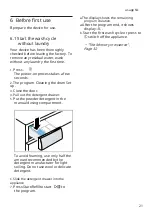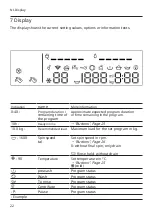
NL Environmental protection and saving
▶
Clean the device only with water
and a soft, damp cloth.
▶
Remove all detergent residues, spray
mist residues or residues immediately
upon contact with the appliance.
Dose detergent according to the
degree of soiling of the laundry.
a For a light to normal degree
of contamination, a small amount
of detergent is sufficient. Follow the
detergent manufacturer's dosing
recommendations.
3 Environmental protection and
savings
Reduce washing temperature for
lightly and normally soiled laundry.
a At low temperatures, it consumes
device less energy. For light to
normal soiling, lower
temperatures than those stated on
the care label are also sufficient.
3.1 Disposing of the
packaging
The packaging materials are
environmentally friendly and can be
reused.
▶
Dispose of the individual components
separately according to type.
Set the maximum speed if the
laundry is subsequently to be dried
in the tumble dryer.
3.2 Energy- and resource-
efficient
a Dryer laundry shortens the pro-
gramme time during drying and
reduces energy consumption. With
a higher spin speed, the residual
moisture in the laundry decreases
and the spinning sound volume
increases.
If you follow these directions, your
device will use less power and water.
Use programs with low temperatures
and longer washing times and use
the maximum load capacity.
Wash laundry without prewash.
a Washing with prewash extends
program duration and increases
energy and water consumption.
a The energy consumption and water
consumption are the most efficient.
The device has automatic load
matching.
Use economical program setting.
a The automatic load matching
ming optimally adapts the water
consumption and the program
duration to the type of textile and the
load capacity.
a When you set the program
For a programme, the display
shows the expected consumption.
12



























